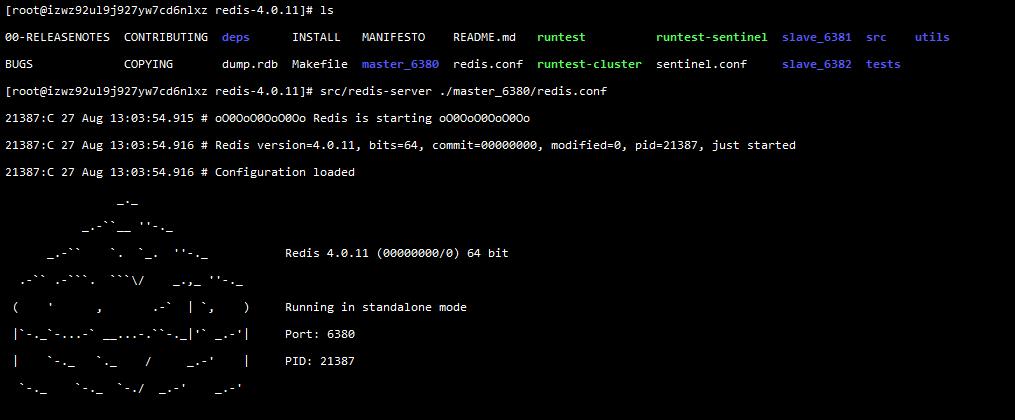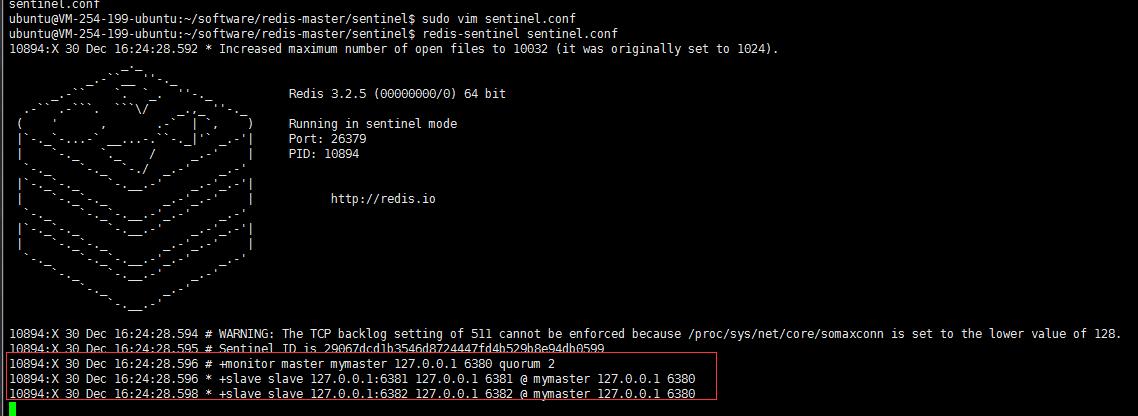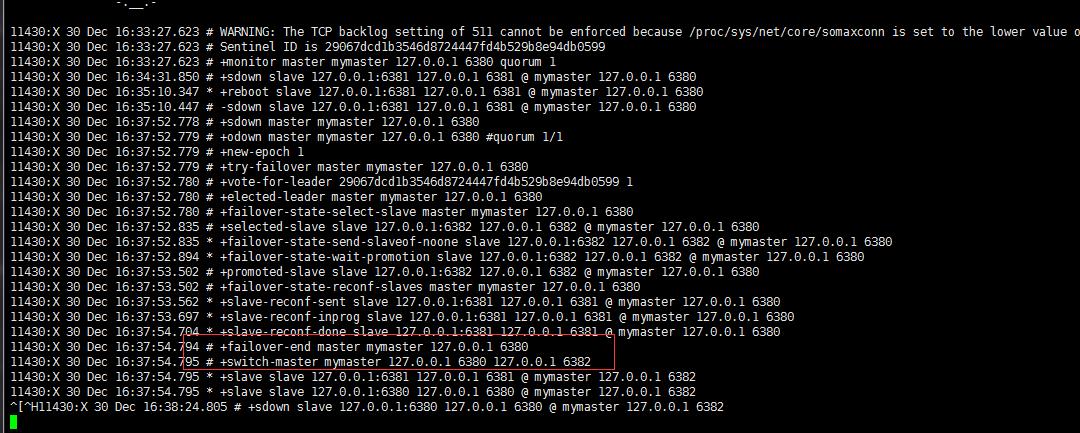Redis 高可用方案 主从及哨兵
Posted 高国藩
tags:
篇首语:本文由小常识网(cha138.com)小编为大家整理,主要介绍了Redis 高可用方案 主从及哨兵相关的知识,希望对你有一定的参考价值。
Redis集群——主从复制以及哨兵模式
##主从复制的定义
Redis的主从复制表示将Redis的服务器分为主服务器(Master)以及多个从服务器(Slaves),其目的是减少主服务器的读取数据的压力。
- 一个 Master 可以有多个该服务器的从服务器
- Master 会一直将自己的数据同步更新到 Slaves 上保持主从同步
- 只有 Master 可以执行写命令,而 Slaves 只能执行读的命令
下面来演示 Redis 的主从复制功能:
-
首先我们启动一个 Redis 服务器,使用默认端口6379
-
接下来我们启动一个Redis服务器在启动时就指定其 Master (也可以启动后再手动指定)
./redis-server --port 6380 --slaveof 127.0.0.1 6379可以看到从服务器已经连接到了主服务器,接下来我们使用客户端连接主服务器写入几个值,然后我们连接从服务器去看看,我们可以看到虽然我们没有在从服务器上面写入数据,但是从服务器已经自动的从主服务器上面复制了数据下来 ,我们再尝试在从服务器上面写入数据。可以看到此时该服务器上是不允许写入数据的。
(error) READONLY You can't write against a read only slave.##主从复制的问题以及哨兵模式的引入 上面我们是通过手动去指定主从服务器的,而且只有主服务器是才可以写入数据,这里有个问题如果主服务器挂了,例如断电了,服务器崩了,那么这个集群也就挂了,所以我们需要一个可以在主服务器挂了的时候有一个机制可以自动的维护这个集群,所以这里 Redis 提供了一个哨兵的机制来保证集群的正常使用。
哨兵 Sentinel的作用是:
- 当主服务器挂了的时候,Sentinel 将会从从服务器中选一个自动提升其为主服务器
- 在步骤1后将其他的从服务器设置为新的主服务器的从服务器
- 主服务器重新上线后,哨兵会使其变为一个从服务器。
- Sentinel 的默认端口是26379
首先,我们默认大家都已经安装了redis,然后我们将 redis.conf 拷贝多份,并且创建多个目录,用于区分多个redis 服务:

这里面,每个目录中都有自己的redis.conf 配置文件,接下来,我们先设置主服务器的配置文件。
一、配置Master
##最后总结一下 Redis 的主从复制解决了数据的读写分离的问题,使业务的读的请求分发到众多的从服务器中去,同时也保证了数据的一致性。哨兵机制则保证了集群的高可用性。
1、修改端口
# Accept connections on the specified port, default is 6379 (IANA #815344).
# If port 0 is specified Redis will not listen on a TCP socket.
port 6380redis 的默认端口是6379,这里我们把主服务器的端口设置为6380
2、修改pidfile
# If a pid file is specified, Redis writes it where specified at startup
# and removes it at exit.
#
# When the server runs non daemonized, no pid file is created if none is
# specified in the configuration. When the server is daemonized, the pid file
# is used even if not specified, defaulting to "/var/run/redis.pid".
#
# Creating a pid file is best effort: if Redis is not able to create it
# nothing bad happens, the server will start and run normally.
pidfile /var/run/redis_6380.pidpidfile 是我们启动redis 的时候,linux 为我们分配的一个pid 进程号,如果这里不作修改,会影响后面redis服务的启动
3、启动 redis

启动redis,我们可以看到,redis已经占领了6380 端口
进入客户端
redis-cli -p 6380
127.0.0.1:6380> info
...
# Replication
role:master
connected_slaves:0
master_repl_offset:0
repl_backlog_active:0
repl_backlog_size:1048576
repl_backlog_first_byte_offset:0
repl_backlog_histlen:0
...我们可以看到,redis 现在的角色是一个master 启动的服务。
二、配置Slave
和上面配置 master一样,我们需要修改端口号和pid 文件,在修改完之后,我们有两种方法配置从服务
- 在配置文件中配置从服务
################################# REPLICATION ################################# # Master-Slave replication. Use slaveof to make a Redis instance a copy of # another Redis server. A few things to understand ASAP about Redis replication. # # 1) Redis replication is asynchronous, but you can configure a master to # stop accepting writes if it appears to be not connected with at least # a given number of slaves. # 2) Redis slaves are able to perform a partial resynchronization with the # master if the replication link is lost for a relatively small amount of # time. You may want to configure the replication backlog size (see the next # sections of this file) with a sensible value depending on your needs. # 3) Replication is automatic and does not need user intervention. After a # network partition slaves automatically try to reconnect to masters # and resynchronize with them. # # slaveof <masterip> <masterport> slaveof 127.0.0.1 6380我们可以在配置文件中直接修改 slaveof 属性,我们直接配置主服务器的ip 地址,和端口号,如果这里主服务器有配置密码
可以通过配置masterauth 来设置链接密码
# If the master is password protected (using the "requirepass" configuration # directive below) it is possible to tell the slave to authenticate before # starting the replication synchronization process, otherwise the master will # refuse the slave request. # # masterauth <master-password>同样的命令进行启动从服务器,可以看到redis已经有两个服务在运行中,我们可以看到,现在有两个现在在运行。
我们进入6381的客户端,看一下他的状态
# Replication role:slave master_host:127.0.0.1 master_port:6380 master_link_status:up master_last_io_seconds_ago:1 master_sync_in_progress:0 slave_repl_offset:71 slave_priority:100 slave_read_only:1 connected_slaves:0 master_repl_offset:0 repl_backlog_active:0 repl_backlog_size:1048576 repl_backlog_first_byte_offset:0 repl_backlog_histlen:0
现在的redis 是一个从服务的角色,连接着6380的服务。
- 在服务启动后设置
slaveof 127.0.0.1 6380 - 总结
# Replication role:master connected_slaves:1 slave0:ip=127.0.0.1,port=6382,state=online,offset=0,lag=1 master_replid:6b53ba0253d09810dec10f9f3d6119a12480371d master_replid2:0000000000000000000000000000000000000000 master_repl_offset:0 second_repl_offset:-1 repl_backlog_active:1 repl_backlog_size:1048576 - 我们如果需要设置读写分离,只需要在主服务器中设置:
# Note: read only slaves are not designed to be exposed to untrusted clients # on the internet. It's just a protection layer against misuse of the instance. # Still a read only slave exports by default all the administrative commands # such as CONFIG, DEBUG, and so forth. To a limited extent you can improve # security of read only slaves using 'rename-command' to shadow all the # administrative / dangerous commands. slave-read-only yes
三、Sentinel 哨兵
- 配置端口
在sentinel.conf 配置文件中, 我们可以找到port 属性,这里是用来设置sentinel 的端口,一般情况下,至少会需要三个哨兵对redis 进行监控,我们可以通过修改端口启动多个sentinel 服务。
# port <sentinel-port> # The port that this sentinel instance will run on port 26379 - 配置主服务和端口
# sentinel monitor <master-name> <ip> <redis-port> <quorum> # # Tells Sentinel to monitor this master, and to consider it in O_DOWN # (Objectively Down) state only if at least <quorum> sentinels agree. # # Note that whatever is the ODOWN quorum, a Sentinel will require to # be elected by the majority of the known Sentinels in order to # start a failover, so no failover can be performed in minority. # # Slaves are auto-discovered, so you don't need to specify slaves in # any way. Sentinel itself will rewrite this configuration file adding # the slaves using additional configuration options. # Also note that the configuration file is rewritten when a # slave is promoted to master. # # Note: master name should not include special characters or spaces. # The valid charset is A-z 0-9 and the three characters ".-_". sentinel monitor mymaster 127.0.0.1 6380 2
我们把监听的端口修改成6380,并且加上权值为2,这里的权值,是用来计算我们需要将哪一台服务器升级升主服务器
- 启动Sentinel
/sentinel$ redis-sentinel sentinel.conf sentinel 启动之后,就会监视到现在有一个主服务器,两个从服务器
sentinel 启动之后,就会监视到现在有一个主服务器,两个从服务器 - 关闭Master
我们手动关闭Master 之后,sentinel 在监听master 确实是断线了之后,将会开始计算权值,然后重新分配主服务器
我们可以看到,6380主服务器断了之后,sentinel 帮我们选了6382作为新的主服务器
4、Sentinel 总结
一、Sentinel的作用:
A、Master 状态监测
B、如果Master 异常,则会进行Master-slave 转换,将其中一个Slave作为Master,将之前的Master作为Slave
C、Master-Slave切换后,master_redis.conf、slave_redis.conf和sentinel.conf的内容都会发生改变,即master_redis.conf中会多一行slaveof的配置,sentinel.conf的监控目标会随之调换
二、Sentinel的工作方式:
1):每个Sentinel以每秒钟一次的频率向它所知的Master,Slave以及其他 Sentinel 实例发送一个 PING 命令
2):如果一个实例(instance)距离最后一次有效回复 PING 命令的时间超过 down-after-milliseconds 选项所指定的值, 则这个实例会被 Sentinel 标记为主观下线。
3):如果一个Master被标记为主观下线,则正在监视这个Master的所有 Sentinel 要以每秒一次的频率确认Master的确进入了主观下线状态。
4):当有足够数量的 Sentinel(大于等于配置文件指定的值)在指定的时间范围内确认Master的确进入了主观下线状态, 则Master会被标记为客观下线
5):在一般情况下, 每个 Sentinel 会以每 10 秒一次的频率向它已知的所有Master,Slave发送 INFO 命令
6):当Master被 Sentinel 标记为客观下线时,Sentinel 向下线的 Master 的所有 Slave 发送 INFO 命令的频率会从 10 秒一次改为每秒一次
7):若没有足够数量的 Sentinel 同意 Master 已经下线, Master 的客观下线状态就会被移除。
若 Master 重新向 Sentinel 的 PING 命令返回有效回复, Master 的主观下线状态就会被移除。
但是主从复制+哨兵机制还有一个问题没有解决,那就是写的请求仍然在主服务器上,因此,如果业务上写数据的请求比较频繁的话,那么主从复置+哨兵机制仍然没有解决问题,这里我们就需要 Redis 自带的原生集群模式了,这个下一篇讨论。
另附上:Redis 设置开机启动
1.编写脚本
[root@localhost ~]# vi /etc/init.d/redis复制下面代码到脚本中(注意要修改里面redis的安装路径,以/usr/redis/redis-3.2.4路径为例)(这段代码就是redis根目录 /utils/redis_init_script 启动脚本的代码)
#!/bin/sh
# chkconfig: 2345 10 90
# description: Start and Stop redis
REDISPORT=6379
EXEC=/root/redis-4.0.11/src/redis-server
CLIEXEC=/root/redis-4.0.11/src/redis-cli
PIDFILE=/var/run/redis_$REDISPORT.pid
CONF="/root/redis-4.0.11/redis.conf"
case "$1" in
start)
if [ -f $PIDFILE ]
then
echo "$PIDFILE exists, process is already running or crashed"
else
echo "Starting Redis server..."
$EXEC $CONF &
fi
;;
stop)
if [ ! -f $PIDFILE ]
then
echo "$PIDFILE does not exist, process is not running"
else
PID=$(cat $PIDFILE)
echo "Stopping ..."
$CLIEXEC -p $REDISPORT shutdown
while [ -x /proc/$PID ]
do
echo "Waiting for Redis to shutdown ..."
sleep 1
done
echo "Redis stopped"
fi
;;
restart)
"$0" stop
sleep 3
"$0" start
;;
*)
echo "Please use start or stop or restart as first argument"
;;
esac3.保存退出,设置权限
[root@localhost ~]# chmod 777 /etc/init.d/redis4.启动redis
[root@localhost ~]# service redis start5.设置开机启动
chkconfig redis on以上是关于Redis 高可用方案 主从及哨兵的主要内容,如果未能解决你的问题,请参考以下文章